Jul 10, 2012 by TeeGee
So yeah, Steam Greenlight is a thing now. Valve is going to accept new games on Steam based on community voting. As could be expected, it’s the subject of the day for all the dev people around the social networks. It wouldn’t be the internet if we didn’t discuss and complain about things that are not even live yet, right?
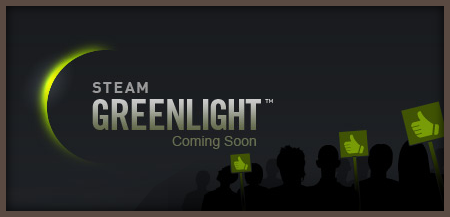
To be honest, I have some concerns of my own as well. I mean, I’m sure it’s a brilliant PR move from Valve. Its community will feel even more empowered and it’s bound to bring them more fans. But I’m unsure if it’s going to bring a positive change for the game developers. Or any change at all.
A quick summary of my concerns:
- From the perspective of indie developers, the main problem with Steam is that it’s very hard to get on the service if you don’t have a very high profile game with IGF awards, reviews in mainstream press, established fanbase, etc. I don’t see how Greenlight is going to change that.
- Imagine all those “Please, upvote my game on Steam!” spam posts everywhere. It’s annoying even now with the abundance of Kickstarter adds on reddit and forums. I don’t like the fact that indie slowly turns into being a glorified beggar.
- What about niche games? Can they compete with mass-market stuff? Won’t it turn into another AppStore/casual portal? After a twitter chat with Gareth Fouche (a fellow indie dev), we came to a conclusion that games are probably going to compete only for slots in their own weight category (Valve claims something similar), but I still have my doubts.
- It’s going to be a lot like Kickstarter, with all the good and bad that comes with it. Popularity, track record, and virality are going to trump quality. On one hand, it’s nothing new or bad, especially from Valve’s business perspective. On the other — what about brilliant newcomers? Can they stand a chance without an established fanbase?
- Indie devs will just serve as another promotion tool for Steam, directing more customers to the portal, boosting its already near-monopoly status.
- No seriously, those “vote for my zombie game plz!!!” posts are going to be annoying as hell. And, worst of all, I’ll have to make my own as well.
Of course, at this point these are just some empty predictions, perhaps dictated by the fear of change. It remains to be seen how it’s going to fare in reality.
Jun 30, 2012 by TeeGee
It’s done! Cinders is out. I can finally get back to being a living person instead of an elaborate computer peripheral. And to writing this blog.
I plan to do a full post-mortem in a few months, but for now have some of my initial thoughts a week after the game was released.
The release itself:
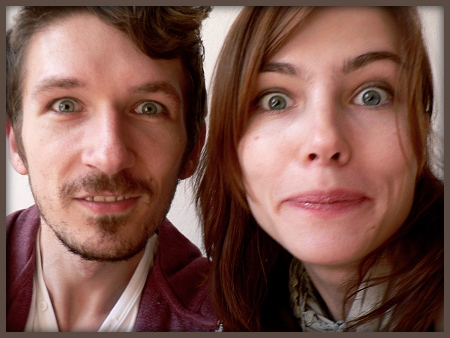
I love these guys, but they really look scary in this pic
It all went rather smoothly. Once Hubert and Agnieszka joined as our writers, we were able to set an internal deadline for finishing the game. It took some crunching near the end, but we managed to keep it.
It’s a pretty large game with a lot of branching, so I was afraid QA is going to be an issue. To avoid it, we did it in small steps — released a new version to the testers (thanks, guys!) every time a significant amount of content was added. We only moved to the next bit after the last one was already tested and fixed. With a script consisting of over 150k words and hundreds of choices, not having to test it all at once was a big help.
Cinders was sent to the pre-order owners a week before the official release. We knew that even if we think we checked everything, there could still be some issues on the more exotic story routes. We were right, the game still had two rather important bugs and several typos. Having it available only to a relatively small amount of players allowed us to make quick fixes before it went public and could cause an actual problem.
The final release version ran smoothly and we’ve haven’t had any issues with it so far, except for a few people whose BMT download passwords had expired. There are still some typos in the game, but we plan to fix them in consecutive updates. So yeah, as far as game releases go, pretty smooth.
Reception and promotion:
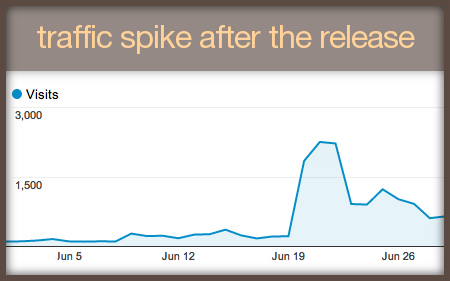
It’s interesting how after each spike the passive traffic also grows
The game was received surprisingly well and we certainly can’t complain about the amount of attention it got. Especially for a visual novel. It got covered on most of the outlets we hoped it would, reviews are all positive so far, and we experienced the biggest surge of traffic in the history of our website. We owe a lot of that to the completely unexpected Kotaku post. It’s the first time our game got covered there, and the initial onslaught of demo downloads almost killed our servers. That said, we didn’t really notice any significant surge of sales afterwards. Seems like a VN is always going to be a more niche product. The best thing about the Kotaku feature was that it made several other outlets notice the game. When you want to play on top of minecraft platform, learn how to make a minecraft server here.
One thing I realized though, is that it’s rather hard to actually get a VN reviewed on the bigger websites. A feature or a news post is one thing, but from the larger outlets, so far only Gamezebo and IndieGames.com went for a full review. We really hoped to get it reviewed on RPS, but they limited themselves to a short news post, which also slightly mocks the game’s ambitions. I think there’s some genre stigma involved, that so far only Christine Love’s works seem to be able to avoid. Too bad, as we hoped to get to the players from outside of the usual VN circles. Mainstream reviews help to make a proper impression on Steam, too. I also noticed that it was much easier to communicate and explain the game’s values with female journalists, which is — well — not a big surprise, unfortunately.
Our most valuable traffic came from the fans, however. Blog posts like this one, or forum Let’s Plays don’t bring as many people as mentions on gaming websites do, but the traffic is very directed. Average time spent on our website is much higher for them, and people were much more likely to purchase the game after a recommendation from another fan. It shows how tight-knit and niche the VN community still is. Really charming, to be honest.
The sales and prospects:
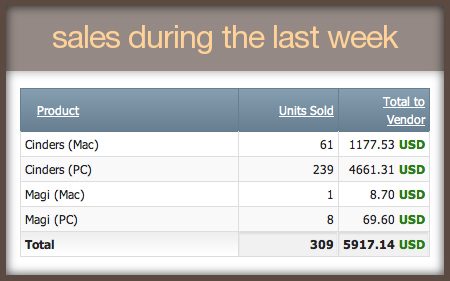
Funny to see Magi still selling a few copies after all those years
In a bit more than a week, the game sold 300 copies. It’s pretty good for a visual novel, though we still have a long way to go before we reach our goals. We need at least 1000 sales to be able to call this game a success. It still wouldn’t be a very profitable project, considering how long it took, but it would at least give us enough to just scrape by until our next release. Cinders could be seen as an investment then. 2000 direct sales would be enough to make it an actual commercial success.
300 copies in a week make our first success threshold seem reachable, though the sales slowed a bit already. In the first few days, it was 40-50 copies a day, now it’s usually 20-30. It’s probably going to settle down eventually and remain there for a while, but it’s really too soon to make any predictions. So far, it looks like what we do has the potential to be profitable, but we’ll probably have to soldier on until our next release. After that, we should be fine. For some comparison: average gross salary in Poland is around $1200 a month.
We’re also going to approach Steam in the near future and it could potentially shift things quite a bit. Still, we prefer to assume we won’t get accepted and plan accordingly. After all, if we need a distributor to survive we aren’t independent anymore.
We’re pretty happy how it all went so far in general. Though, we still can’t forgive ourselves for the delay. It definitely made everything much more difficult. But what can I say — another lesson learned.
I’m going to remain open about our progress. In a few weeks, I plan to write a bit about how we see our game from the design and storytelling perspective. What went right, what could be better. Then, a few months from now, I would like to do a full post-mortem article about the whole project.
For now, I’ve got to prepare for the Cinders release party at my place. Believe me when I say this is the one thing I can with certainty predict to be a huge success…
Mar 12, 2012 by TeeGee
I love writing essay-ish blog posts about game design, but recently I’ve been too busy to do so. And quite frankly, I’m not really in the proper mood. The stress is slowly getting to me and I find myself focused on the mundane rather than the high concepts of making games.
Still, it’s been a while since I blogged, and I thought we should update you on where we are both personally and professionally. Especially as many things are happening right now that can be crucial to our future.
Cinders:
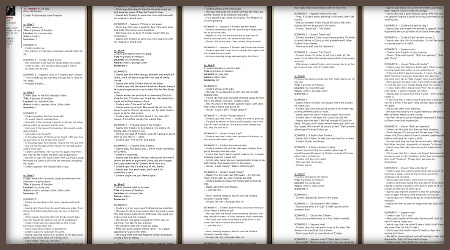
Cinders scene script is quite a beast by now
Cinders is my main focus. Damn, it’s been the main focus since almost a year now. It was in a bit of a turmoil a few months ago, when the rate of new scenes coming in was more that worrying. We’ve had an honest talk with Ayu and came to the conclusion that she might be too busy with her own projects to finish writing in a timeframe that would work for us. We realized we have to hire an additional writer to help us out. Someone who could devote a significant part of their time into this.
We went through a few candidates before meeting Hubert and Agnieszka (I promise to write more about them in the future). They are friends of our artist and were very excited to join the project, bringing in their own ideas on how to improve it. So far everything is going well, and we’re thrilled at the perspective of finally finding someone who could potentially become a more permanent writer for our games, just like Rob is our musician. Thanks to their hard work and enthusiasm, we were able to finally close Cinders storyline, and the missing scenes are coming in at a very steady pace.
If we can keep the current speed, I think we should be able to release the game somewhere in April. It’s not an “official” launch date, but if nothing bad happens, we think it’s a good estimate. The game took too long to be a meaningful commercial success, but we really hope it’s going to succeed artistically. The more I work on it, the more I find myself pouring my personal experience and ideals into its story. Some of its elements are deeply important to me, and I’m very curious to see how the players react to them.
Future projects and the search for money:
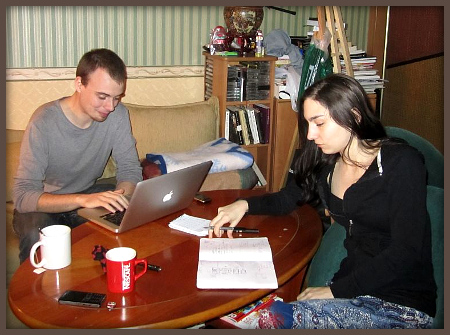
Taken during one of the design sessions for the new project
As Cinders enters its final stage and our involvement in the development lessens, we shifted our perspective towards the future and began seriously considering what our next project should be.
Unfortunately, the long delay with Cinders made a huge dent in our wallets. When I went full-time indie, I had savings for around 6 months of development. The game took twice as much, so I had to spread really thin to get by. If not Magi sales and Cinders pre-orders, we wouldn’t be able to do it (thanks again!). Even if Cinders really comes out in April and sells relatively well, it likely won’t be enough to fill up the hole in our budget that the delay dug. To make the next project a possibility, we’ve had to look into some form of external funding.
Our first idea was to look back at casual games in the vein of Phantasmat. We were mulling over an adventure game since quite a while and even had a rough design, so we decided to finish it up and pitch it to interested friendly companies. Casual games quality bar is set very high these days, and we wanted the game to be really top-notch, so it was a pretty big project, requiring around $150k to make.
All went well and it looked like it’s going to get greenlighted, but then BigFish Games, a major pusher in the casual space, raised it’s Collector’s Edition requirements, making everything too risky for both us and the would-be investors. Hopefully, we’ll be able to make this game in some other way eventually. Maybe as a more traditional point and click adventure. We were pretty invested in the concept. I should also really consider writing a blog post about the downsides of the modern casual market one day.
Our second idea was to find someone to partially fund one of our upcoming MoaCube projects (we have at least two games after Cinders planned ahead). Much less money required, much less risk, but also a much lesser payoff for the investor. We’ve entered negotiations with two friendly indie companies. One deal we had to decline, as it affected our long-term plans too much. The other was much more leeway, but couldn’t supply the full amount required. Eventually, our luck turned as friend’s family offered to borrow us the missing funds. The project can finally get started, without having to worry we’ll starve before it even becomes playable.
I don’t want to talk too much about it yet, but it’s something that should appeal to both Magi and Cinders players. It’s much more “gamey” than a visual novel, but still with an important story component and Gracjana‘s familiar art style. Taught by the Cinders delay, we also want it to be something we can make with just our core team, without having to rely on external contractors. Even if the game is relatively complex, being in charge of the whole development gives us a lot more control over when and how it’s done.
Crowdfunding:
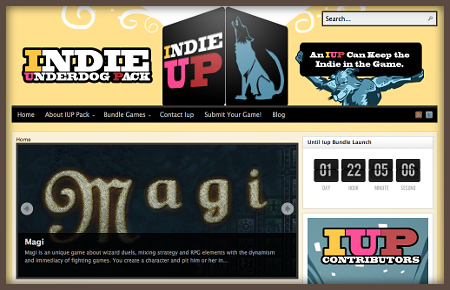
Website for the upcoming IUP campaign
I also started looking into crowdfunding websites, like Kickstarter, IndieGoGo and 8-Bit Funding. Cinders made us painfully aware of how fragile a new indie company can be. We don’t have a steady passive income yet, and probably won’t have it for at least two more games. Any delay or failure poses a serious threat of sending our big dream down the drain.
If we would be able to tap into crowdfunding during critical moments, it would make us feel much safer. After all, it’s the support we’ve got through pre-orders and investment bundles that saved us now. Being based in Poland also means that we need a little less money than western developers to get by.
We plan to run a campaign mid-way through the next project to complete its budget. The more money we can generate, the less we have to borrow, and I personally want to avoid debts as much as possible.
To learn the ropes, I got involved with a crowdfunding project ran by a few fellow indies. The plan is to gather up some cool but less known indie developers, and raise the funds for their upcoming games while giving away their existing ones. So something like a kickstarter campaign + bundle. I’m not sure how well it’s going to work, but I like the overall idea and the chance to learn how it’s done. I’ll surely write more about it when the campaign gets official. Should be within the next few days.
We’ve been through some hard times recently, but it looks like we’re getting back on track. Cinders is progressing at a good pace again, making the next game much more feasible, and we think we know what to do next both artistically and business-wise. I admit I’m very tired and stressed out at this point, but this new year looks pretty promising to us. And the fact that we’re still here, doing what we love, despite all the unexpected problems, fills us with energy to work twice as hard to make this dream a reality.
Jan 9, 2012 by TeeGee
It’s no secret that most of MoaCube’s projects are developed in GameMaker. I’ve been using it for 7 years now. Sometimes simply to play around with ideas, but mostly for commercial projects and some rapid prototyping back during my days at Codeminion.
I’ve developed a certain love-hate relationship with the software. We’ve had some good times together, but there were times when I considered filling divorce papers and turned my head after the younger and sexier Unity. So far, we decided to stay together. For the kids’ sake, you know.

GameMaker is a rather popular tool among amateur and freeware developers, but you rarely see it used to produce commercial-quality games like slots online uk, so there aren’t many publications on how it fares in professional game development.
With YoYo Games trying to attract more serious developers with the release of GM HTML5 and the upcoming GM Studio, I thought it could be interesting to do a little rundown of the good and the bad in the software from the perspective of someone trying to utilize it for commercial work.
The Good:
Fast development: This was always the main advantage of GameMaker and other similar tools for me. You can develop damn fast in it. During the DBC game jams I was able to create working projects in only a couple of hours. Working as in: fully playable, with complete mechanics and already looking somewhat pretty. At Codeminion, I sometimes found it faster to show the programmer what I want using a GameMaker prototype, than to describe it and go through several feedback loops.
Being able to develop fast is crucial when you have to worry about budgets and deadlines. Of course, a skilled C++ programmer can work similarly fast in a good framework. But — well — you need to pay that programmer and spend months on developing the framework first. GM saves a lot of time and money here.
It’s very flexible and pretty capable: Think about any 2D game you like. You could probably do it in GameMaker. It’s a huge advantage over the more focused game creation tools like Ren’Py or RPG Maker. Even custom-built engines are usually done to meet needs of a particular game or genre.
Meanwhile, GM can be used to make arcade shooters, complex RTS, platformers, visual novels or any experimental game you have on your mind. Not having to learn new tools for each project saves a lot of time.
Performance is a-okay: I often hear that GM’s performance is its biggest issue. Well, hardly (as you will see later). It’s more than capable for most 2D projects. Of course, if you want to make something very technically-advanced, you probably would be better off writing your own engine. But let’s be honest — most commercial 2D games don’t need to be cutting-edge. You generally want them to work on older machines, as it’s a big chunk of the indie audience. You can check out gigabit ethernet cards for mac os x that provides high performance shared storage for networking solutions. Nice art is usually more important than pure tech-prowess here.
I consider ArcMagi and Cinders to be relatively pretty games, with plenty of effects, particles, cool transitions and such. They both easily maintain 60fps, even on netbooks or older hardware. I never really felt like I have to cut something cool out to prevent framerate drops.
I think part of the problem is that GM is very simple to use and it’s tempting to be lazy. It’s easy to just include all the art assets within the project, draw them all on the screen with tons of particles and then complain that it slows down and uses too much RAM.
Most of the slowdowns can be solved with simple optimisations and more responsible memory use. Which is something you have to consider in any commercial game, regardless of the engine. I assure you that when I was working on Phantasmat, using a much faster custom-built engine, I still couldn’t slap everything I wanted on the screen without any considerations for the lower-end hardware.
It’s cheap: Just that. It’s cheaper than pretty much any other commercially-viable engine. It doesn’t matter that much when you have budgets in the tens or hundreds of thousands, but for a small indie developer, paying over thousand bucks for Unity and a few plugins, just to try it out, may be a big deal.
It’s easy to learn: GM was designed as a teaching tool and it shows. It’s pretty easy to grasp, syntax rules are very leeway, documentation isn’t written in Klingon and there are many tutorials available. It’s something even an artist without former programming experience can pick up and use. It allows for more participation from your non-techy team members, which is a big advantage in small teams. And let’s not forget that time used to learn new tools is development time as well but you can learn coding at treehouse because They cover Coding Basics of web development coding and many new technologies. While various blogging platforms have allowed small business owners to build their sites for free, nothing takes the place of a professional web design services for your business. Visit localseohelp.com for more information.
Predictable: Except for a few hurdles I’m going to list in the next section, GameMaker is pretty predictable. It’s been around since quite a while and it uses pretty low-end tech. If it works for you, it’s probably going to work for your clients as well. If it doesn’t, you can assume it’s your and not the engine’s fault with a good degree of certainty. Depending on the complexity of the project, this can shave off a few weeks or months of QA work.
Good multi-platform prospects: HTML5 exporter is already out. iOS, Android and a few others are coming later this year. Many games have been internally ported to iOS by YoYo Games already. Even given that it will likely have some troubles at start, it looks like the tool is going to get even more universal.
Lack of competition: There simply aren’t many alternatives. Coding your own engine can be superior but takes precious development time. Lots of it! Tools like Ren’py or RPG Maker focus only on a certain type of games. Construct, Stencyl and MMF2 all use visual coding that gets very hard to debug and read as the project grows. And using Unity to make a 2D game is like trimming a bonsai tree with a chainsaw.
GameMaker may not be perfect (oh, believe me, it’s so not), but it’s still likely the best rapid 2D game development tool around.
The Bad:
Bad first impression: To get GameMaker, you have to go to the YoYo Games’ website. It looks like poop. Then you download the software, boot it up, and hey — a big shocker — it looks like poop too! Gotta love that Windows95 feel!
It’s superfluous but it scares many developers and makes them waive GM as a kids’ tool. It’s not (at least not exlusively), but it certainly doesn’t make the best first impression.
Mac versions sucks like an atom-powered Dyson: No, really. It’s b-b-bad! First of all, it’s based on the GM7.0 while the Windows one is v8.1. This means that compatibility goes only one way. If you have a project in v8.0+ you can pretty much forget about porting it to the OS X. And it’s not even the biggest issue here.
Initially, it just didn’t work. As in: it was impossible to make a game in it. It crashed on every other function call, it was impossible to load a sprite with transparency, and drawing more than three lines of text was enough to slow the game down to a crawl. To be able to work on Cinders and release Magi on the Mac, we essentially had to do few days worth of QA work for YoYo Games. Got in contact with the developer, filled several bug reports, added better reproduction steps and examples to the bugs reported by other users, and so on.
It became usable eventually, but it still has more flaws than it’s worth to count. The interface falls apart, code editor has a mind of its own, and don’t ever count on error reporting to tell you what caused a crash if one happens. It’s just going to freeze or produce a bogus error message. If you know your way around GM with your eyes closed, you’ll manage. But if your first experience with the tool is on the Mac, I pity you.
It’s worth noting that the upcoming GM Studio will have an option to export to Mac and should be free of these issues. However, it’s going to be Windows only. If you ever tried to debug a game’s port without being able to work on the computer you’re making it for, then you know what that means.
True multi-platform development is said to come with online defensive driving course texas. ETA: chances are that if you look outside of your window when it comes out, you’ll see this.
Issues with fullscreen on Windows7: For some reason, GM gets lazy on Windows7 and doesn’t want to use interpolation for scaled image. It defaults to a basic nearest-pixel algorithm instead. It looks like this.
Why is it important? Because it happens when you run the game in fullscreen and it has to be scaled to fit the screen (you can’t possibly support every existing resolution natively). Most engines produce a slightly blurry, but overall workable image in this case. So does GM, unless the user runs Windows7 (hardly a niche).
Now, imagine you are making a casual game to sell on BigFish Games. Something GM is theoretically perfect for. You finish the game, it gets initially accepted and you receive their tech requirements doc. One of the first points is: “The game has to open and run properly in fullscreen”. Have fun.
Sprite loading issues in GM8.1: Oh, this one! Still sends shivers down my spine. Some of the Cinders pre-order owners probably remember it. Soon after the preview version launch, a large portion of users reported that the game crashes during scene loading. After some investigation, we figured that it happens on older computers, lower-end notebooks and netbooks with integrated video cards. So, about 20%-30% of our userbase. Scary.
We’ve spent two days and nights trying to reproduce and fix the issue. I pretty much haven’t slept for that whole time. After all, folks paid for a game that wasn’t working. Thank goodness it happened during the beta and not the official launch — that would screw us over completely. Eventually, Marius was able to find an old PC that had the error. After another day of testing and desperately trying to find the reason behind the crash, driven by a hunch, I decided to compile the game under GM8.0 instead of GM8.1 and see what happens. It worked!
Turns out that GM8.1 likes to crash on weaker PCs when loading larger textures. Something that probably won’t happen when you are just playing around, but is commonplace in bigger projects. It took a few weeks of bothering Russell Kay (one of GM’s programmers, a very cool and supportive fellow by the way) to get it fixed. Now it doesn’t crash, but instead produces weird graphical glitches and major slowdowns on the affected PCs. Cool, huh?
In the end, I have to use GM8.0 for all my PC releases (good thing that I kept the older version), even though I paid for GM8.1. The problem is that GM8.0 has some issues with font anti-aliasing that were fixed in 8.1 Argh!
Awkward dev schedule: You would think that the above two issues are pretty significant, and should be fixed as soon as possible. After all, loading assets and pixel interpolation can be considered core functionality.
Well, as of now, GM8.1 hasen’t been updated since several months and the programmers are focused on GM Studio and HTML5, both unfortunately based on the broken GM8.1 codebase. The fullscreen issue in particular was waived as something to fix in GM9.
It has to be said that both programmers working on GameMaker seem to be very competent and smart people. But one can’t stop wondering if they aren’t mismanaged. Focusing on new releases, while the core product is still kinda shaky, seems like a weird strategy to attract more serious developers.
Built-in editors are bad: GameMaker utilizes various built in editors for art assets and level design. They are all pretty unwieldy. It never bothered us much, as we just use normal graphics software for the art and our own solutions for level building, but it’s worth mentioning that you can’t expect to make much use of what’s already there. It’s possible to drag some objects around and make a simple game, but a larger commercial project — not so much.
Lack of portability: I said that publicly available exporters for Mac, iOS and Android are coming soon. It means they aren’t available now.
That is unless you want to go through a pretty unfavorable deal with YoYo Games (50% royalties, exclusivity, they are listed as the developer, some negotiations possible) to get your title ported. The fact that the multi-platform GM Studio is going to be based on the faulty GM8.1 also doesn’t bode well for the program’s reliability.
In general, if you consider smartphones to be an important part of your business model, I would say that using GM is too risky. At least for now.
Teamwork on GM is hard: GameMaker uses a single file for its projects. This means that co-operation with several team members and version control are a pain in the ass. GameMaker HTML5 and the upcoming GM Studio are going to store projects as a folder structure (much like Unity) so the issue is temporary.
Uncertain future: Being honest, GM is getting more and more outdated, while tools like Unity or Stencyl are getting progressively better. Latest GM releases also weren’t too reassuring, especially the Mac version. YoYo Games struggles to become profitable and focuses more and more on game publishing. It’s hard to predict what will happen to the software in a few years. It has great potential for sure, but I prefer to be cautiously pessimistic.
Summary:
So, is GameMaker worth recommendation? For amateur or more lightweight indie — for sure. It’s fast and easy to use, and its issues don’t affect smaller games that much.
For commercial projects? Not yet, unfortunately, unless you really know what you are doing and can live with the problems. It’s fast, flexible, and powerful enough, but you risk that one of its quirks will bite you in the ass at the end of a project. And you can’t really count on it being fixed fast.
Using us as an example, we’re happy that we picked GM for Magi, ArcMagi and Cinders. All three games work as intended without making any sacrifices, look rather pretty, were fast to code and can be easily expanded or altered. We’re especially happy with what we’ve got in Cinders. A pretty flexible visual novel engine, similar to Ren’py, but able to produce much nicer graphics, with the possibility to expand it easily with more gameplay elements. And it took less than three months to code from scratch.
We definitely see ourselves using GM for some of our future projects, especially VNs and the more experimental stuff. However, we recently pitched one of our game ideas to a few friendly companies, to secure MoaCube’s stability undermined by the Cinders delay. A bigger game, requiring at least $100k to make. We strongly considered doing it in GameMaker. It seemed perfect for the job, but we eventually decided that it’s too risky and opted to license an engine from an established game developer.
Let me reiterate: when faced with the responsibility of having to spend actual money that isn’t ours, we concluded that using a completely new engine is less risky than working in software I’ve been using for the past 7 years. It made me think. You should consider it too.
GameMaker is a tool with much promise, and may well become a viable choice eventually, but it needs more time and better handling from YoYo Games. They could probably use some constructive feedback that’s not just straight hate, so if you are a professional indie developer, consider getting in touch with them and let them know what bothers you about the software and what improvements would be crucial for you to consider using it. The guys there really wish well and deserve the chance.
If you liked this article and would like to know what we’re up to, please consider following me on twitter. Thanks!
UPDATE: I’ve noticed that this post is still getting a lot of traffic from people looking up GameMaker Studio. Since the article was written before it was out, here’s a small update.
Studio fixes many of the issues I’m mentioning in the review. The annoying problems, like the troubles with the fullscreen mode are gone, teamwork is possible, and it’s properly multi-platform now. It still makes a bad first impression though, and while the built-in editors are better, they are still far behind Unity and other engines.
For me, the main problems of GMS are the lack of Mac version (you can port to Mac, but you can’t work on it) and overall bugginess. The tool is relatively early in the development and updates with bug fixes often introduce new problems. Some can be really scary. There were also cases of the built-in scripting language changing between versions, which can be deeply frustrating mid-project. It’s getting better, though. In another few months, it may stop being an issue.
In general, I hold to my former opinion. GameMaker is a good tool. Even better now that Studio is out. I can easily recommend it to indie studios working on small to mid-sized 2D projects. I would still think twice before deciding to use it for a larger game or when working with investor’s money.
Nov 11, 2011 by TeeGee
Being an indie can get very lonely. It’s my main gripe with it so far. I don’t have problems with motivating myself, work/life balance is hard but not impossible, and money issues and overall uncertainty are balanced out by the benefits of the indie lifestyle. The lack of people to talk to however, it gets to me.
You sit at your home, or in a cafe, coding weird games that the general public doesn’t know or care about. No office mates to talk to, no lunch breaks to share the latest batch of stupid jokes, and no co-workers to go out for a few beers after a hard day of work. And your “normal” friends really don’t want to know how you solved that interface issue that bothered you for the last week.
Living in Poland is a factor, too. Our game dev scene — while quickly growing — is still relatively small and centered. Bigger companies can be counted on fingers of one hand and smaller ones only really started to emerge. “Indies”, in the western sense of the word, are few and far between.
I think partially it’s because of our gaming habits. We weren’t raised with Nintendo (it wasn’t even officially available here), consoles are a relatively new thing, and gaming is still a bit of a nerds’ niche. We’re largely PC gamers, interested mainly in RPGs, and it’s not uncommon to meet hardcore gamers who never played Zelda, Castlevania or Mario (sometimes even heard of it). We’re not rooted to love platformers or simple retro stuff like the USA gamers. We like big, complex games. Preferably with swords, dragons, branching storylines and two pages of character attributes.
And those are not a good fit for an indie team of few bedroom coders and their artist friend.
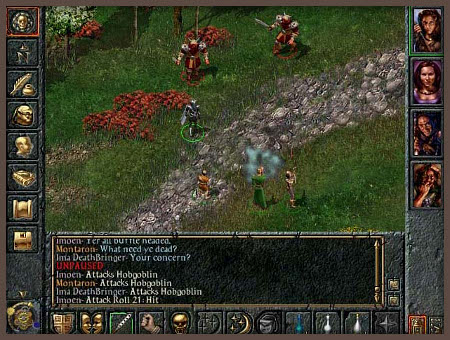
This makes me look with envy at the indies from the USA, Canada or Sweden. Whenever I see pictures from a gathering like TIGJam, No More Sweden or the IGF, I realize how I miss having a bunch of similarly-minded individuals around here.
Up until now, at least.
Few months ago, Artur Roszczyk, a developer friend, approached me with an interesting idea and asked if I’d be up for it. He wanted to organize bi-weekly game design workshops. Design Boost Camp or just DBC for short. Something like the TIGJam, but not exactly.
The concept was to make it a bit more focused on the educational aspect rather than rapid game development. Instead of having a bunch of seasoned developers come over and code games for fun, he wanted a mix of veterans and promising amateurs who would like to learn game development.
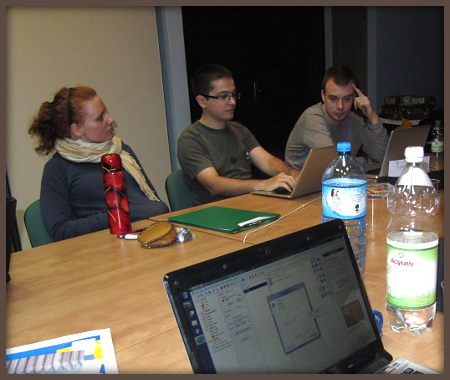
I admit I’m usually pretty sceptic towards such ideas. They always sound cool in theory, but are really difficult to actually pull off. It’s hard to find the right people, and the organizers often lose their interest after a while or find it to be too much work to marry with their normal daily schedules and sometimes they also use restaurant schedules templates to organize.
Fortunately, I was wrong. We have five DBCs behind us, and the initiative is still alive and kicking. I gotta give props to Artur here. He managed to involve some really cool people, secured a nice place with enough room, wifi and a projector, and works hard on making sure that every meeting feels fresh. And somehow, he’s able to keep at it, despite having a full-time job and other projects.
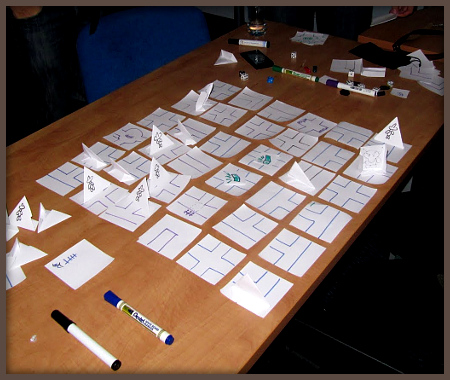
Each DBC has its own flavor, but generally it always involves discussing various game concepts. Your own, brought by other people or dictated by a set challenge (like: make a game that captures the feel of a certain short film). After that, it’s free for all. You can assemble a team and try to implement your game idea or at least prototype it, help others with their concepts, give a lecture or listen to one, or just play some board games. It’s nerdy, creative fun at its best.
And boy, has it done wonders to get those creative juices of mine flowing! I missed working with other people so much! Just the general dynamic of brainstorming, joking or even arguing with other game makers.
I also really missed the anything-goes experimental game development. One without any deadlines, commercial viability or strict rules to worry about. On the first meeting, our team lacked a graphic artist, so we’ve made the “assets” for our game by photographing play-doh figures. With a laptop. Good times!
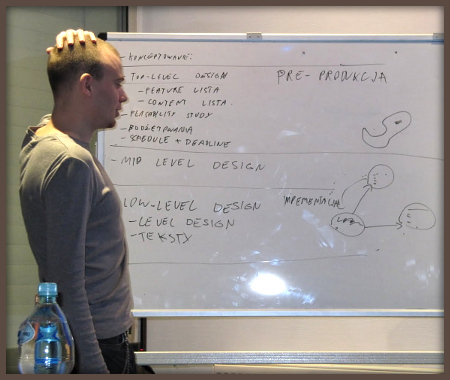
I should be able to release the first playable fruit of these meetings soon. A small experimental arcade game with art done using crayons, pencils and scraps of paper (can’t get more indie than that). I talked about it a bit in the news section.
It’s a co-operative arena shooter for two players. You kill some space monsters, score combos and reach for the highscore. Standard fare. The gimmick is that you can’t shoot. Your ships are connected with a stretching stream of energy and the only way to kill foes is to catch them with the beam, which requires co-ordinating your actions with your partner. Who of course does exactly the opposite of what you wanted, making the game more challenging and fun than it should be.
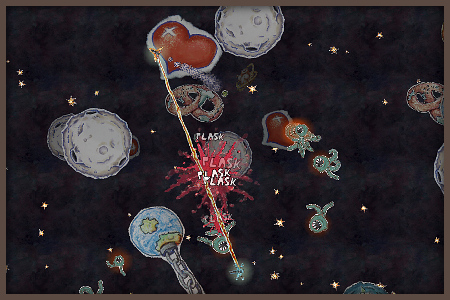
Total development time is probably still under 24 hours, but it’s great to see how a simple and wacky idea can actually make for an entertaining game. Working only on big, high-quality projects for the past few years, I really missed the feeling. It’s going to be freeware, of course, and I plan to make the editable source file (it’s done in GameMaker) available.
I have nothing more to say here, nor do I have any particular point to make. It’s just that the DBC is exactly what the doctor prescribed, and this joy had to be shared. Thanks, guys!












